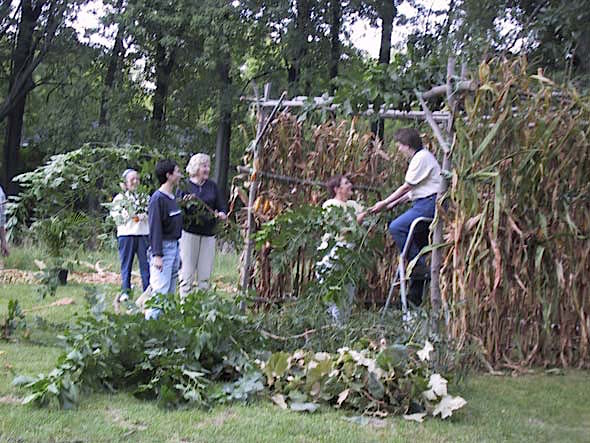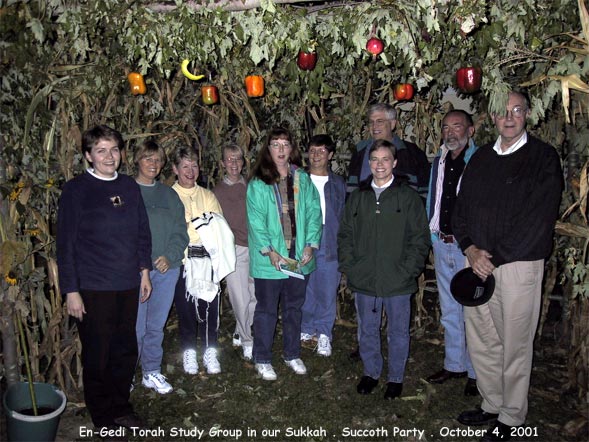 Five days after the Day of Atonement comes the most joyous feast of the year—the Feast of Tabernacles, or Sukkot. Sukkot is the plural of the Hebrew word sukkah, meaning “booth” or “hut.” During Jesus’ day, huge celebrations were held in the temple, lasting for seven days.
Five days after the Day of Atonement comes the most joyous feast of the year—the Feast of Tabernacles, or Sukkot. Sukkot is the plural of the Hebrew word sukkah, meaning “booth” or “hut.” During Jesus’ day, huge celebrations were held in the temple, lasting for seven days.
The Feast of Sukkot is also called the “Feast of Ingathering” because it is the greatest harvest feast of the year—when the fruit was brought in and the rest of the wheat was harvested. When the feast was inaugurated, God told his people to build booths and live in them for seven days in order to remember how he had brought them out of Egypt and cared for them in the desert.
To this day, many Jews observe the tradition of building a sukkah. These are supposed to be made from impermanent materials, fashioned so that at least one star is visible through the branches that comprise the roof. The custom is to live in it if possible, or at least to eat your meals in it as if it were your home.
As you sit in one of these rickety little booths, peeking up at the sky through the branches and feeling the wind blowing through the walls, you realize that security comes not from the walls you construct around yourself, but from the Lord who protects you.
You also begin to realize the abundance of God’s blessings. The Feast of Sukkot offers a potent experience of what following God is like—feeling both insecure and incredibly blessed at the same time. For Jews, it is a time of great joy as they remember the intimacy of those forty years when God “tabernacled” with them in the desert, sustaining them each day with manna from heaven.
Experiencing Life in a Rickety Tent
Lois recalls when her friends Bruce and Mary Okkema built a sukkah in her backyard along with their Bible study group. “Bruce and I,” she says, “were busy preparing for a huge worship celebration, a kick-off event for our new ministry, the En-Gedi Resource Center. I’ll never forget that brilliant September morning when we drove over to a local radio station to be interviewed about the event. Suddenly, in the middle of the interview, a DJ popped his head into the studio and said: ‘We’re going to need to break in for a news bulletin about a plane accident in New York.’
The World Trade Center had just been struck. Our ministry had barely begun when the events of September 11 threatened to sink it. The events of that day paralyzed our country. So many lives were lost that the nation was plunged into mourning. And there was mounting fear that more terrorist attacks would follow.
In the ensuing months, Bruce’s business was hard hit by a faltering economy, as were many others. As for myself, I had left a tenure-track professorship to help begin the ministry, confident that people would support us. That fall the strong brick walls of my cozy little house felt as shaky and breezy as the walls of the sukkah in my backyard. Those first years with En-Gedi were truly a ‘journey through the wilderness,’ as we began to discover what it meant to rely on God for our security.”
Praying for Living Water
Israel’s own journey through the wilderness is brought vividly to mind every summer. For six months, between May and October, not a drop of rain falls, so that by mid-fall, when the Feast of Sukkot is observed, the land is parched and dry. The lush spring greenery has shriveled and died.
 No wonder, then, that Sukkot was the time to pray that God would send “living water,” or rain, for the coming year. About one out of four years, the rains were late or not plentiful enough for good yields, so rain was a critical need and a common worry. At that time of year, it was easy for people to remember how dependent on God they had been in the desert of Sinai.
No wonder, then, that Sukkot was the time to pray that God would send “living water,” or rain, for the coming year. About one out of four years, the rains were late or not plentiful enough for good yields, so rain was a critical need and a common worry. At that time of year, it was easy for people to remember how dependent on God they had been in the desert of Sinai.
How does the Feast of Tabernacles figure into the life of Jesus? On the last day of that feast, the priests performed a water libation ceremony accompanied by impassioned prayers for life-giving water in the form of rain. At that point the joyful voices of thousands of worshipers reached a thunderous intensity. One rabbi commented, “Anyone who has not seen Simchat Beit Hashoevah [the water drawing ceremony] has never seen joy in all of his life!”
It was on this last and greatest day of Sukkot that Jesus stood up in the midst of the clamorous crowds and shouted: “Let anyone who is thirsty come to me and drink. Whoever believes in me, as Scripture has said, rivers of living water will flow from within them” (John 7:37–38).
Imagine! Jesus was speaking of the living water of the Holy Spirit that he would soon pour out on new believers. This was the water that would fill up their thirst for God and bubble out of them to refresh the whole world. Through him God would give a never-ceasing supply of life-giving water, welling up in them from now until eternity.
~~~~~
Excerpt from Sitting at the Feet of Rabbi Jesus (Zondervan, 2009)

Steve says
For us Sukkot points to the rapture of the believer.
The sukkah is an impermanent structure, meant during the time of Moses to be dismantled and re-assembled over and over again during Israels’ journey to the Promised Land.
Our bodies, like the sukkah are temporary structures, daily being regenerated at the cellular level, but ultimately subject to corruption – except for rapture and/or resurrection :
Knowing that shortly I must put off this my tabernacle, even as our Lord Jesus Christ hath shewed me.
2 Peter 1:14
For we know that if our earthly house of this tabernacle were dissolved, we have a building of God, an house not made with hands, eternal in the heavens.
2 Corinthians 5:1
Notice that the ‘roof’ of the sukkah must be permeable, and ‘open’ with branches (products of the soil) (Rabbinically one must be able to see at least 3 stars through it at night). At the rapture, we shall go ‘up’ through our temporary, permeable bodies to meet Jesus of Nazareth…
Michele Bartlett says
For me, the Sukkah points to Believers going (at least partway) through the tribulation. Psalm 27:5 says that in the day of trouble — literally, yom ra-ah, evil, bad — he will hide me “b-sukkoh” — in his sukkah. Not his strong tower, not his fortress, but his flimsy hut — but it’s enough when he is in it with us.
Where is the rapture for the Christians in the Middle East right now? Or those slaughtered by Pol Pot, or killed in Nazi camps, or during the Red Purge in Communist China? Why would any Jew want to believe in a Torah-less, lawbreaking so-called Messiah who would snatch away His followers who eat pigs, divorce at the same rate as the rest of the world, and at least in the west live in materialistic ease while their co-religionists are suffering the world over, but leave His own Brothers to suffer through a massive tribulation? (I am speaking as my Jewish friends might.)If for NO OTHER reason (though there are plenty), that’s enough reason for me to hold the pre-trib…
Janet Hughes says
I believe the final Feast of Tabernacles or Feast of Ingathering is where the Church of the Lord Jesus will shine the brightest, with all nations pouring in to her (Isaiah 2:1-3) as she reaps the final harvest for her Lord.
How will that be accomplished if the Church is raptured so they don’t have to endure the tribulation?
I agree with Michele Bartlett. I believe the Church will go through the tribulation (partial or full) but as there was light in Goshen, so God’s hand will be on His Church protecting her in the midst of it.
Michael Meszaros says
Hi! We are so excited to find your website and see that you also make a branch hut for Tabernacles! We are from Vancouver Canada and would love to connect with you.
We’ve been keeping all the feasts since 2013, and love how the Bible describes them.
“Go forth unto the mount, and fetch … branches of thick trees, to make booths, as it is written.” Neh.8:15
I have also discovered how to not have the result of “feeling insecure” or “going through the wilderness” or having troubles after keeping a feast like you have described. May I have your permission to share it with you, for your consideration.
God bless you!
Michael Meszaros
http://www.DayOfAtonement.ca